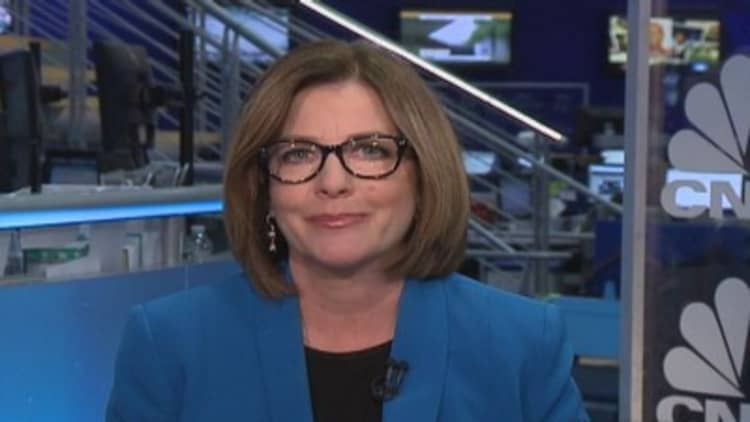
The shakeout in stocks is likely to continue, as investors worry there is too little proof the economy can accelerate enough to counterbalance the Fed's reversal of its easy money policy.
It wasn't the jobs number that sucker-punched the stock market Friday and continued to pound stocks Monday; March nonfarm payrolls were just what was expected. But the 192,000 jobs was not a blow-away number that proved winter weather was behind the several months of weak data.
Meanwhile, the Fed should remain on track to pare back its quantitative easing program, and it is expected to take another $10 billion off its bond buying program at its meeting at the end of the month, bringing its monthly purchases down to $55 billion.
"I think it's spooking people to some degree. Rates are resorting back to normal, or natural levels. They've been distorted for so long," said Clifford Noreen, president of Babson Capital. "I think it's very healthy for the Fed to be pulling back on their monthly purchases."
But the Fed policy has also been a factor helping stocks rise, particularly those that were the hottest in the market—the momentum names that typically have the lowest profits but the most growth prospects.
Peter Boockvar, chief market strategist at Lindsey Group, believes it's all about the Fed. "I'm still amazed at the complacency with the Fed taper, and a lot of people still don't think it's a big deal," he said. "I just don't think it's a coincidence that the high-fliers are getting popped when the Fed is half way done with QE. We've got tightening smack in front of your face with the taper."
Read More 2 charts tell the whole story of value vs. growth
Noreen said many of the momentum stocks that started the selling cascade were overpriced and trading at levels they shouldn't have seen for several more years.
"I tend to look at the fundamentals," he said. "They're almost like cult stocks that had a really high amount of momentum in them and once they go the other way, the fast money sells out. That's what was happening in this group of stocks."
Noreen said the selling can continue but the market losses will likely be shallow.
"If there was a material correction going on, you'd see a crack in credit spreads. We haven't seen that. It's been very solid. You also have margin selling," he said. "Margin debt was at record levels. It's healthy to have that flushed out, and that's probably what's going on."
Stocks also face the next big catalyst of earnings, starting this week with Alcoa on Tuesday and JPMorgan and Wells Fargo on Friday.
Though estimates have been knocked down, traders fear companies will blame weather for misses, adding further murkiness to the outlook for growth and profits. Earnings are expected to grow by just 1.2 percent for the first quarter, after last quarter's 9.9 percent gain.
Noreen said the anecdotal industry surveys are positive, and for the most part, he sees companies talking favorably about business.
The Nasdaq continued its disproportionately large decline Monday, after Friday's more than 2.5 percent decline. The Nasdaq was off 1.1 percent in afternoon trading, while the Dow and were off about 0.8 percent. The small cap Russell 2000 was off 1.6 percent, and the S&P 400 midcap index was off 1.4 percent, trading below its 50-day moving average.
The iShares Nasdaq Biotech ETF, IBB, was actually slightly higher Monday. The ETF has been at the leading edge of the momentum stock decline and is widely watched. It's down 12 percent in the last several weeks and more than 4 percent in the last five sessions.
Traders also point to the fact that selling that started weeks ago in biotech, Internet and social media stocks has spread to the broader market, and leaders are defensive names like utilities, up 0.6 percent, and consumer staples, up 0.5 percent.
As stocks slid, buyers loaded up on bonds and Treasury yields dipped, with the 10-year sliding to 2.68 percent.
John Briggs, head of cross-asset strategy at RBS, said he expects the 10-year to stay in a range of 2.60 to just above 2.80. "I don't think we're breaking the range until the next employment report," he said.
The economy has not yet shown that it is accelerating, as many expected. "If you hand off from QE3 to growth, things should be OK, but I still think you have a little bit of a weather issue," he said. Briggs said the rise in yields in the 2- and 5-year sector was overdone.
Those yields rose after Fed Chair Janet Yellen said last month the Fed could move to raise short end rates within six months of the end of quantitative easing. Since then, Fed officials have been more vague about the timing.
Briggs said the market is now anticipating this week's 3- and 10-year note and 30-year bond auctions. The next big event for the bond market will be Yellen's speech at the Economics Club of New York next week.
"It's supply in the near term, but Yellen's speech next week is expected to be dovish," he said. Some of the buying in bonds was short-covering.
"You can't just sit on a bond market short for a month," he said. "It's easier to be long without a reason, but you can't be short without a reason."
—By CNBC's Patti Domm.




